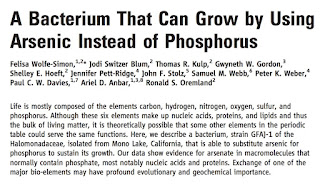 I'm becoming increasingly disturbed by the behaviour of Wolfe-Simon's arseniclife coauthors. She shared the credit for the work with 11 other authors but, in the year since the tide of support turned, the senior author is the only one to have said even a word to support her or defend the work. And even he mostly says 'No comment' or 'We'll wait for the peer-reviewed responses'. All of the authors signed the Response to Comments published in early June, so I presume they stand by the work. Why then is Wolfe-Simon the only one speaking up to defend it?
I'm becoming increasingly disturbed by the behaviour of Wolfe-Simon's arseniclife coauthors. She shared the credit for the work with 11 other authors but, in the year since the tide of support turned, the senior author is the only one to have said even a word to support her or defend the work. And even he mostly says 'No comment' or 'We'll wait for the peer-reviewed responses'. All of the authors signed the Response to Comments published in early June, so I presume they stand by the work. Why then is Wolfe-Simon the only one speaking up to defend it? David Dobbs made this point very well in a post last September on his Wired Neuron Culture blog (Arsenic is Life and the View From Nowhere):
Meanwhile, I know that part of what unsettles me about this story, regardless of how much sympathy one feels is due Wolfe-Simon (and I generally lean toward sympathy), is how both NASA and her mentors and former lab heads seem to have abandoned Wolfe-Simon. It appears they bought and fueled the bus; put bright lights and banners on it; cheered as Wolfe-Simon drove it a bit wildly honking the horn; and have now thrown her under it.Here's the author list from the paper. Some of these people are junior members of the Oremland group, or of other research groups, but others are senior scientists with their own NASA-funded laboratories:
- Felisa Wolfe-Simon: The lead author, at that time a NASA-funded postdoc in Ron Oremland's group.
- Jodi Switzer Blum: A long-time member of Ron Oremland's group.
- Thomas R. Kulp: At the same USGS Menlo Park laboratory as Ron Oremland; has been publishing with them and others since 2004.
- Gwyneth W. Gordon: Assistant Research Scientist in Ariel Anbar's group.
- Jennifer Pett-Ridge: Scientific staff member at Lawrence Livermore National Laboratory. Expertise: Environmental microbial ecology; biogeochemistry; stable isotope probes for analysis of nutrient cycling, molecular genomics of environmental microbial communities, subcellular imaging via TEM and NanoSIM.
- John F. Stoltz: Director, Center for Environmental Research and Education, and Professor, Environmental Microbiology, at Duqueyne University. Expertise: microbial arsenic transformation, chromate reduction in the presence of high nitrate, community structure in modern marine stromatolites.
- Samuel M. Webb: A beam line scientist at the Stanford Synchrotron Radiation Lightsource (SSRL) in the Structural Molecular Biology (SMB) program.
- Peter K. Weber: Scientific staff member at Lawrence Livermore National Laboratory. Expertise: Environmental geochemistry; microbial geochemistry; elemental and isotopic tracers; salmonid migration and survival; and mass spectrometry.
- Paul C. W. Davies: Director of the Beyond Center for Fundamental Concepts in Science and co-Director of the Cosmology Initiative, both at Arizona State University.
- Ariel D. Anbar: Professor at Arizona State University. Expertise: environmental chemistry of bioessential and redox-sensitive transition metals, using the isotope biogeochemistry of iron, molybdenum and other “non-traditional” stable isotope systems to examine changes in metal availability through time, particularly in the Precambrian, and to develop novel isotopic biosignatures.
- Ronald Oremland: Senior Scientist with the USGS Laboratory at Menlo Park. Expertise: microbial metabolism of reduced gases (e.g., methane, ethane, methyl halides, acetylene), and of toxic elements including selenium, arsenic, tellurium, mercury, and antimony.